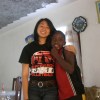 The day started off with something a bit new: for the first time this trip, we had a little rain. While waiting at the clinic, we discovered that school would open a little late due to the rain. Back at home, I know school only closes with torrential rain, snow, or natural disasters. It is important to keep in mind the kind of terrain the kids have to walk. The windy, uneven paths are practically impossible to tread with the added problem of mud.
The day started off with something a bit new: for the first time this trip, we had a little rain. While waiting at the clinic, we discovered that school would open a little late due to the rain. Back at home, I know school only closes with torrential rain, snow, or natural disasters. It is important to keep in mind the kind of terrain the kids have to walk. The windy, uneven paths are practically impossible to tread with the added problem of mud.
The school itself held around 40-50 kids, with 10 teachers. The kids were separated in grades from 1-6, and left to their respective “classrooms.” The building, roughly the size of one normal American classroom, was separated into three areas by two chalkboards. The boards were made by fitting slats of wood that were painted black together. As you can imagine, erasing the boards was a much more difficult challenge than it is for us.
From there, we split into different groups and tutored the different grades. We moved from group to group, mentoring kids with different learning styles and books. As we participated in an end of day reflection, we found that we had all taught with different styles. For example, some of us tutored one-on-one, in small groups, or by incorporating fast-paced games. We were told that teachers normally teach in a more rigid, rote style: the teacher stands in front of the classroom while the kids sit and read. Being exposed to new ways of teaching can help kids discover their passion for learning.
The passion with which kids learned was more than outstanding. For one student I tutored in particular, I was pleasantly surprised. At the beginning of the lesson, Andre knew how to multiply a number by a one-digit number and basic division. By the end, he could correctly perform 4-digit by 4-digit multiplication, rules for long division by a 1-digit number, and worked how to count places (i.e. ones, tens, hundreds) up to the ten million places. From what I learned from others, everyone had a successful time teaching kids literal things. Some continued reading from the students’ books by working on specific pronunciation skills and reading aloud for them.
At the same time, it is important to keep in mind the lessons that we learned from the kids. It is very heart-warming to know that kids around the world have that same passion to learn. There might always be those who don’t believe in learning, but there should also always be those who are excited to learn and looking forward to their future. In fact, even after the bell rang and lunch break was in session, two students came up to me asking for more questions. When I asked them if they wanted to learn, their responses were almost always an eager “yes!”. They came asking for more types of problems. In fact, one of my fellow tutors kids’ looked at my board and asking if her tutor could teach her the same kind of work. I think the biggest lesson to learn is to not to take what we have for granted. These kids have so much less resources than us, yet the percentage of kids looking to learn is much greater than the percentage in my local high-school back home.
From here on out, know it is my duty to make the best of the opportunities that I come across. I know Andre would.
Jessica Sun
